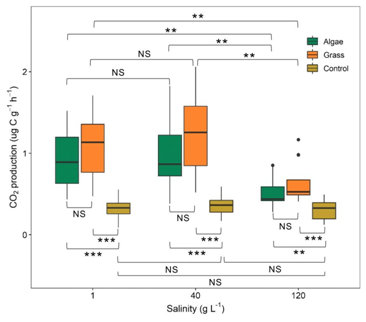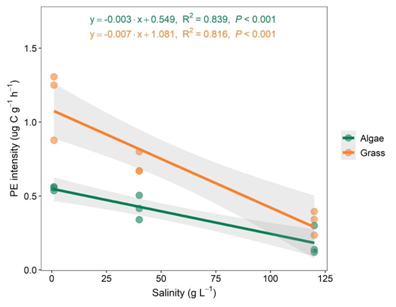Abstract
Ecological consequences of the increased input of allochthonous and autochthonous organic matter (OM) remains unknown in saline lakes. Here, we reported microbial mineralization of algal and grass OM (represented by autochthonous and allochthonous OM, respectively) in lake sediments with different salinity (1, 40, and 120 g L−1). The addition of algal and grass OM significantly increased the CO2 production rates in the studied sediments. Algal and grass OM input can induce positive priming effect (PE). PE intensity induced by grass OM input was significantly higher than that by algal OM input. PE intensity induced by algal and grass OM input decreased with increasing salinity. Bacterial taxa affiliated with Actinomycetia, Alphaproteobacteria, Bacilli, Bacteroidia, Clostridia, and Gammaproteobacteria played important roles in driving PE generation in the studied sediments. Our finding suggested that the PEs induced by allochthonous and autochthonous OM should be considered in saline lakes that are intensively influenced by climate change.
Key Points
Allochthonous and autochthonous OM input can induce positive priming effect (PE) in saline lake sediments
Allochthonous OM input caused stronger PE intensity than autochthonous OM in saline lake sediments
Positive PE intensity increased with decreasing salinity of saline lakes

Figure 1Boxplots showing the range of CO2 production rates measured on the 1st, 5th, 7th, and 15th day in the studied sediment microcosms with different salinity. Wilcoxon rank-sum tests: **p < 0.01, ***p < 0.001, NS p > 0.05.

Linear relationships between the priming effect (PE) intensities (on the 7th day) induced by the addition of algal and grass organic matter and the salinity of the studied sediment microcosms.
Conclusion and Environmental Implications
In recent years, water level has increased continuously with the expansion of lake surface area and algal blooms have occurred frequently in the QTP saline lakes, due to the impact of climate change and human activities (Huisman et al., 2018; Woolway et al., 2020; Zhang et al., 2020). The resulting inundation of onshore grass and degradation of algal blooms caused by lake expansion led to input of a large amount of grass and algal OM to the QTP saline lakes. Our results demonstrated that the input of algal and grass OM in the studied lake sediments promote microbial activity and accelerate CO2 production, resulting in positive PE generations. PE intensity decreased with increasing salinity. Bacterial taxa affiliated with Actinomycetia, Alphaproteobacteria, Bacilli, Bacteroidia, Clostridia, and Gammaproteobacteria may play important roles in driving PE generation in the studied sediments. The results presented in this study suggest that the current ongoing desalination process will further enhance CO2 production and positive PE intensity of the QTP saline lakes. Considering the total area of saline lakes on the QTP and their contributions of CO2 emission (Ran et al., 2021; Zheng, 1997), especially under the condition of continuous climate change, the impact of allochthonous and autochthonous OM input on organic carbon processing and storage should be taken into account when assessing carbon cycling in QTP saline lakes.
Title: Positive priming effects induced by allochthonous and autochthonous organic matter input in the lake sediments with different salinity.
Authors: Yang, Jian, Han, Mingxian, Zhao, Zhuoli, & Jiang, Hongchen
DOI: https://doi.org/10.1029/2021GL096133